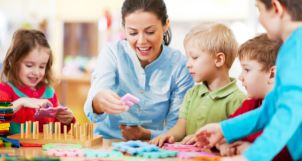Teaching children to play puzzles will bring many benefits to their development. However, how to teach children how to play without being restrictive but still effective is something that worries many parents. Please refer to this article with us to find the answer!
Introduce puzzles early to teach children how to play with puzzles
Teaching children to play puzzles will be easier when they already know the concept and how to play. You should choose puzzle toys that are appropriate for your child's age and ability. For example, toy sets with few pieces and large pieces will be for children under 5 years old.
In case your child is too young, instead of directly letting your child play with puzzles, you need to choose activities such as combining letters, numbers, or simply arranging pictures in order so that the child can gradually get used to it. . In the process of teaching children to play puzzles , parents should also ask questions and encourage children to think so that they have the opportunity to find the solution themselves. At the same time, create a comfortable and fun environment so that children feel excited and actively participate in playing puzzles.

The earlier your child learns about puzzle toys, the easier it will be for you to teach them to play puzzles
Move on to more difficult puzzles when appropriate
Of course, to achieve the goal of developing children's puzzle skills, increasing the difficulty of games is necessary. When the basic puzzles cannot be difficult for your child anymore, that is, the child has enough ability and experience to solve these puzzles, then this is the right time to increase the difficulty a bit. little.
Increasing the number of puzzle pieces or choosing puzzles with smaller piece sizes will make it more difficult for children, stimulating their efforts. Besides, you can also teach children to play puzzles by giving puzzles with new colors to confuse them, or switching to puzzles with irregularly shaped pieces. By applying different elements such as size, shape and color, you can challenge your child's intelligence and encourage their development.

You can increase the difficulty so your child doesn't get bored
Adds more challenge to the puzzle game
Competitive challenges are always loved by children because they have the opportunity to prove themselves and their abilities to those around them. You can take advantage of this to make your child diligently hone their skills while assembling puzzles. First, you can ask the child to complete the product without looking at the instructions. This will encourage children to develop their thinking ability without relying on direct information and practice the ability to visualize images in their head.
The second way to teach children to play puzzles better is to set time limits. Use a timer and have your child complete the puzzle in less time than before. Time pressure will encourage children to concentrate and increase their thinking speed during the puzzle solving process. Before giving a puzzle to your child, hide one or two pieces. This will make completing the product more difficult and requires children to think to discover that the product set is missing pieces.

Puzzles with missing pieces stimulate children's thinking to find solutions
By applying these methods, you will create new challenges for children when playing with puzzles. This will promote children's development in spatial thinking, concentration ability and flexibility in problem solving. Make sure the puzzles remain within your child's ability, while providing appropriate challenge to encourage their progress and development.
Put the puzzle together and don't forget to give your child suggestions
When you join your child in solving a puzzle, it will bring a lot of fun and motivation to them. Your support will encourage your child to try their best to complete the puzzle. At the same time, it is also an easy way to strengthen family connections and spend quality and fun time together.
In case your child has difficulty or feels stuck and doesn't want to build anymore, you should teach them to play puzzles by completing the product themselves to build their confidence. Children will believe that they can also assemble the puzzle. Besides, you can provide some clues instead of directly intervening. For example, if your child can't put two pieces together yet, you can ask, "Do these two pieces seem to not match?" Or if your child doesn't know what the next piece is, you can suggest that he or she continue to insert it at other easier locations (for example, from the border of the puzzle).

Playing puzzles together also brings fun family moments
Teaching children to play puzzles not only brings extremely exciting moments of entertainment, but also enhances children's ability to concentrate, promotes creativity and develops their thinking ability. After being assembled, the finished products can be framed and displayed on a bookcase, desk, or study table... as a souvenir of the memorable time and efforts your child put into completing the product. this product.




